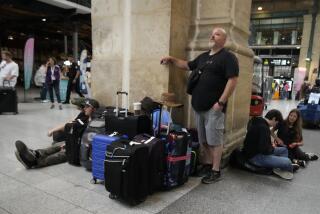Millions Stalled as Japanese Radicals Sabotage Government-Owned Rail Lines
- Share via
TOKYO — Cutting vital communications cables, saboteurs paralyzed all commuter services on Japan National Railways trains in Tokyo and two major lines in Osaka today, stalling 10 million commuters in the capital and 200,000 in the nation’s second largest city.
Police and government officials said they suspect that the sabotage, in 32 separate attacks on Japan National Railway (JNR) facilities and stations, was carried out by radicals supporting an ultraleftist faction of a railway union. The union staged a wildcat strike Thursday on a railway line linking Tokyo and Chiba city.
40 Arrests Made
By noon, 48 people, including the three top leaders of the Chukaku-ha (Middle Revolutionary Faction), noted for its 15-year struggle against Tokyo’s Narita International Airport, had been arrested.
The ultraleftist splinter union staged the strike, the first major government rail walkout since 1981, to protest plans of the government of Prime Minister Yasuhiro Nakasone to transform the debt-ridden National Railways into seven private companies and carry out drastic cuts in the work force.
More than 90,000 of the 276,000 rail workers are expected to lose their jobs in the reform, designed to reduce debts of more than $100 billion.
The communications lines--some of which contained 200 separate wires feeding data into a highly computerized system--were cut between 3 a.m. and 5 a.m. and prevented all the government’s commuter trains in Tokyo from beginning their morning runs.
Privately owned rail lines and the subway system were not affected.
During the morning rush hour, delays involving as many as 30,000 private-railway commuters occurred at the key transfer points of Shinjuku and Ikebukuro stations in Tokyo as they attempted to take subways. Passengers were forced to wait as long as 90 minutes to board the subways.
Commuters who switched to automobiles in an attempt to get to work created traffic jams of as long as 28 miles on expressways leading into Tokyo.
More than 50 schools in the Tokyo area closed for the day.
Slow Coming Back
As of noon, service had been restored on only four of 21 JNR commuter lines in Tokyo. Most of the lines were expected to remain paralyzed through the evening rush hour, and police warned motorists that highways were expected to remain crowded until as late as 11 p.m.
Rail lines in Osaka, however, were expected to resume operations by mid-afternoon.
One segment of a bullet line between Hiroshima and Mihara was put out of service for 2 1/2 hours until 8:30 a.m., but other bullet trains were unaffected.
The cable sabotage also cut off many computerized ticketing services.
Intensive Probing
Nakasone instructed his Cabinet to carry out intensive investigations of the incidents and punish offenders severely. He also condemned the Chiba prefecture chapter of Doro (the National Railway Motor Power Union) for its illegal strike. As federal employees, the rail workers are forbidden to strike.
Doro’s Chiba chapter bolted from the national union in 1979 to support Chukaku-ha radicals opposing operation of Narita airport and government plans to build a second runway there.
Leaders of both Doro and Kokuro (Japan National Railways Workers Union) condemned what they called “the anti-social” guerrilla attacks on the railway service and offered their apologies for the inconvenience caused commuters.
Although no injuries were reported, radicals set fires at 27 locations in seven prefectures (states) ranging as far away as Hiroshima. Major fire damage occurred at Asakusabashi Station in Tokyo.
The guerrilla attacks shocked the government because they exposed the fact that the communications cables had been laid above ground. They contain electronic devices that automatically stop and start trains and control speeds, switches and signals.
Legislation needed to dissolve the government rail system and divide it into private companies has not yet been passed--and efforts to enact it next year are considered certain to precipitate more protests.
More to Read
Sign up for Essential California
The most important California stories and recommendations in your inbox every morning.
You may occasionally receive promotional content from the Los Angeles Times.










